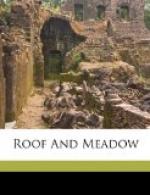I had now entered the high, overhanging swamp, where the shaggy trees, the looping vines, and the rank, pulpous undergrowth grew thick on both sides, reaching far back, a wet, heavy wilderness without a path, except for the silent feet of the mink and the otter, and the more silent feet of the creek, here a narrow stream winding darkly down through the shadows.
Every little while along the rooty, hummocky banks of the creek I would pass a muskrat’s slide. Here was one at the butt of a tulip-poplar, its platform wet and freshly trodden, its “dive” shooting sheer over a root into the stream. Farther on stood a large tussock whose top was trampled flat and covered with sedge-roots. I could not resist putting my nose down for a sniff, so good is the smell of a fresh trail, so close are we to the rest of the pack. In the thick of the swamp I stopped a moment to examine the footprints of an otter at a shallow, shelving place along the bank, where, opening through the skunk-cabbage and Indian turnip, and covered almost ankle-deep with water, was the creature’s runway.
I had moved leisurely along, yet not aimlessly. The whole June day was mine to waste; but it would not be well wasted if nothing more purposeful than wasting were in mind.
One does not often drift to a port. Going into the woods to see anything is a very sure way of seeing little or nothing; and taking the path to anywhere is certain to lead one nowhere in particular. Many interested, nature-loving people fail to enjoy the out-of-doors simply because they have no definite spot to reach, no flower, bird, or bug to find when they enter the fields and woods. Going forth “to commune with nature” sounds very fine, but it is much more difficult work than conversing with the Sphinx. In order to draw near to nature I require a pole with a hook and line on the end of it. While I watch the float and wait, if there is any communion, it is nature who holds it with me through the medium of the pole. I need to have an errand to do; some berries to pick, a patch of potatoes to hoe (a very small patch); an engagement to keep, like Thoreau, with a tree, if I hope to squander with profit even the laziest summer day.
I was heading up-stream toward a deep sandy-sided pool that was bottomed, or rather unbottomed, by the shadows of overhanging beeches. The pool was alive with racoon-perch. A few mornings before this, a boy from a neighboring farm had come to fish here and had found a fisher ahead of him. He was just about to cast, when back under the limbs of the beeches the water broke, and a mink rose to the surface with a fine perch twisting in her jaws. Straight toward the boy she swam till within reach of his rod, when she recognized the human in him, turned a back-dive somersault, and vanished.
Would she be fishing again this morning? I hoped so. It was her hour—the hour of the rising mist; visitors rarely found their way to the pool; and I knew the appearance of the boy had given her no lasting alarm.




